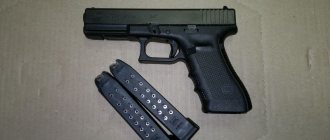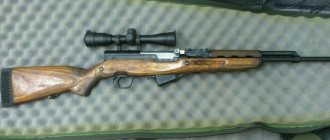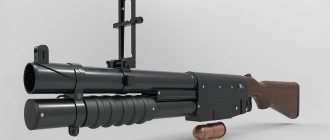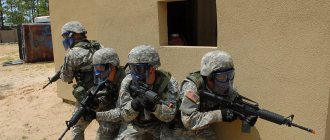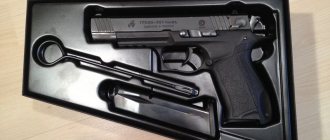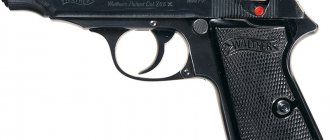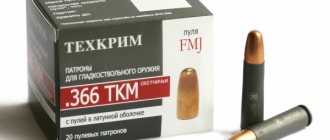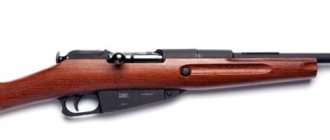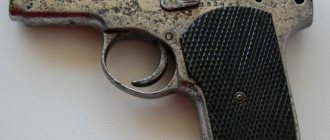The Soviet weapons designer Kalashnikov is famous for the pistol he developed. This page in the development of domestic weapons has remained little known. It is worth noting that this model was created to a high level of craftsmanship, but was not put into mass production. Nevertheless, she had important virtues and deserves to be known.
This is what the weapon looked like
The history of the creation of the Kalashnikov submachine gun
This development by the designer Kalashnikov is one of his first works. In 1942 he proposed two models of a submachine gun. Almost no information has been preserved about the first of them. This article talks about the second one.
In the nineties, rumors spread that Kalashnikov was not a specialist in his field, but simply used other people’s work. The history of the creation of the 1942 submachine gun is actually the history of the formation of a talented gunsmith who created a weapon that has received recognition throughout the world. In 1942, the master became fascinated by the idea of creating the perfect small arms and began working on them from scratch.
The first options cannot be considered successful, but they already showed his special style of work. Reviewers noted the originality of the solutions he proposed. The negative aspects of the weapon appeared due to the fact that the novice designer at that time did not yet have the necessary experience.
The very first development used the principle of blowback. It was not used subsequently.
Kalashnikov was wounded during the fighting. This happened in October 1941 near Bryansk. During treatment, he began to think about the idea of creating a perfect automaton. At this time he did not have any special education, but he became enthusiastic. Kalashnikov did not want to waste his treatment time in vain and decided to start creating a new weapon.
He began making diagrams and drawings, trying to figure out what it should look like. His combat experience allowed him to better imagine the features of the new weapon. He showed the results to his comrades and took their advice. It is known that several sensible comments were made by a paratrooper who was undergoing treatment with him. The latter, before the start of the Great Patriotic War, worked at a specialized research institute and understood small arms systems.
After the hospital, doctors sent Kalashnikov for further treatment. For this purpose he was granted six months' leave. At the time of discharge, the future designer had a notebook with hand-drawn drawings of parts and a general diagram of the weapon. He was determined to bring the work on the weapon to the creation of a prototype.
The first version of the machine gun design was created in Matai during the first three months of forced leave. To create weapons, Kalashnikov returned to the locomotive depot, where he began his career. Development has reached the creation of a prototype. This was the first version of the Kalashnikov assault rifle. Not a single copy of it has survived to this day. Even information about him is fragmentary.
The efforts of the senior sergeant were highly appreciated and he was sent to Alma-Ata to continue his work. Further developments were carried out in the workshops of the Moscow Aviation Institute, which were located in this city during the war.
This work made it possible to create a second, more advanced model of the machine gun. The result was shown to A. A. Blagonravov, who was in this city at that time, who was the head of the Dzerzhinsky Military Engineering Academy. He was an outstanding specialist in the weapons field.
His review actually launched the career of a young weapons designer. Although it emphasized the negative aspects of the development, it nevertheless noted some of the positive characteristics of the weapons created by Kalashnikov and recommended sending the aspiring weapons designer to undergo further systematic training. In 1942, he was sent to serve at the Central Research Site of the Main Artillery Directorate of the Red Army. It was not only a place where trials took place. There was a powerful technical and production base here, which made it possible to effectively work on improving weapons.
The weapon was refined from August 1942 to February 1943. Here it was necessary to eliminate about two dozen comments. Work on this weapon helped the novice gunsmith gain experience in the development of small arms. The mistakes and shortcomings made became an incentive for more efficient work in the future.
You can see what the 1942 PPK looked like in the video
At the beginning of the Great Patriotic War, the Degtyarev submachine gun was in service. Then it was replaced by the PPSh - Shpagin submachine gun. The infantry went through the entire war with the latter and reviews about it were mostly positive. However, a weapon was needed that had to be used in a confined space. For example, light weight and miniature dimensions were important for the tank crew. Therefore, the Main Artillery Directorate of the Red Army set the task of creating such an assault rifle. The PPK was intended primarily to solve such a problem.
Subsequently, documentation on the assault rifle created by Kalashnikov was sent to the Main Artillery Directorate of the Red Army for further training. Although its experts noted several shortcomings, in general they gave a positive description of the created brand of weapons, but did not recommend the development for adoption into mass service in the army. The conclusion was based on technological considerations associated with this weapon model. In terms of combat characteristics, the PPK was not inferior to, and in some cases superior to, existing models.
In this and the following years, Kalashnikov developed a light machine gun (1943) and a carbine (1944).
In 1947, an assault rifle was introduced into service, which won recognition throughout the world. It was developed, among other things, on the basis of a model created in 1942.
Self-loading carbine
In addition to the PPK, the USSR People's Commissariat of Defense also rejected another prototype of Mikhail Timofeevich's small arms - a self-loading carbine of 7.62 mm caliber (SKK). This weapon is the first Kalashnikov model to use a rotary locking scheme. The carbine had increased strength and reliability.
In 1944-1945, Kalashnikov developed two models of self-loading carbines for an experimental intermediate cartridge with a sleeve length of 41 mm. Subsequently, the bullet with a lead core was replaced by a longer one with a steel core, and to maintain the overall length of the cartridge, the length of the cartridge case was reduced to 39 mm. The result was the 7.62mm Model 1943 cartridge, also known as the 7.62x39 cartridge.
The self-loading (the principle is similar to an automatic weapon, but the trigger must be pulled separately for each shot) Kalashnikov carbine was considered a very reliable model. Based on the comments, Mikhail Timofeevich tried to correct the weaknesses of the SKS (Simonov Self-loading Carbine), and in 1945 the carbine entered state testing.
However, by the end of World War II, the idea that the army had a greater need for mass-produced automatic weapons prevailed. In this regard, Kalashnikov decided to focus entirely on creating an assault rifle, which eventually became the most popular in the world.
The Kalashnikov self-loading carbine has been characterized as a weapon with increased strength and reliability when used in difficult conditions. Despite the fact that the carbine itself was not adopted for service, some developments formed the basis of the AK.
In particular, the receiver cover is fixed by the protrusion of the return mechanism rod, which began to be used in many other Kalashnikov models. Mikhail Timofeevich’s assault rifles up to the AK-74M received a silhouette of the front sight base similar to a self-loading carbine.
Performance characteristics of the Kalashnikov submachine gun 1942
| Characteristic | Parameter |
| Weight of weapon without ammunition | 2.9 kg |
| Barrel length | 250 mm |
| Number of cartridges in the magazine | 30 |
| Weapon length with stock folded | 535 mm |
| Length of weapon with butt in firing position | 750 mm |
| Ammo used | 7.62x25 TT |
| Sighting range | 500 m |
| Rate of fire | 824 rounds per minute |
The goal of the development was to create a weapon that would be convenient for use by soldiers. The simplest and most reliable design was used for it. The disadvantage was the need to use complex technological operations in its production.
The rate of fire after modification was reduced from 824 to 600 rounds per minute. At a high rate of fire, ammunition is consumed less efficiently.
Sniper rifle
In 1959, Kalashnikov took part in a state competition to create a new sniper weapon for the Soviet army. Mikhail Timofeevich sent a sample of the Kalashnikov self-loading sniper rifle (SVS) for testing. Famous designers Evgeny Dragunov, Alexander Konstantinov, Sergey Simonov took part in the competition.
The Kalashnikov sniper rifle was created in two versions. The second sample, unlike the first, largely repeated the design of the AK, essentially representing its enlarged version chambered for a more powerful 7.62x54 mm cartridge and without the ability to conduct automatic fire.
The Kalashnikov rifle was inferior to the Dragunov model in terms of accuracy of fire, but it turned out to be lighter and smaller. As a result, the Dragunov sniper rifle, SVD, was adopted into service with the troops in 1963, which subsequently underwent many changes.
The structure of the Kalashnikov submachine gun
A free-sliding bolt was used for firing. The distinctive features of its design are the following. It is not connected to the barrel during movement. The work uses a retarder, which slows down the recoil after the shot. Reloading is performed by using the energy of the shutter movement after the shot.
The deceleration occurs due to the operation of two screw pairs from the bolt group. In this case, a rotary coupling-screw shank and a gate-rotary coupling are used. Movement during rollback is carried out along the guides of the tail box.
During operation, the coupling rotates, but the shank remains stationary. To prevent rotation, fixation is carried out using a protrusion, which is located in a groove located at the end of the receiver. During the movement, the coupling, screwing onto the shank, is turned out when moving out of the gate. The return spring is also a combat spring.
It can be noted that the clutch and the shutter move in opposite directions. As they run away, they slow down the speed of the rollback. As a result, the time it takes to fully open the shutter increases. This operating scheme is considered unique for the type of weapon in question.
The weapon uses a percussion-type firing mechanism. The shot is fired with the shutter closed. In this case, the start sear is pressed onto the firing pin sear. The striker is cocked during the rollback of the moving parts. Moving away under the action of the clutch, it jumps with its annular protrusion behind the spring-loaded sear of the striker.
The bolt cocking handle is rigidly connected to it. It is located on the left side.
The machine provides both automatic and single fire. A flag fire translator is used. It is located on the left side of the trigger frame. It combines the functions of a fire switch and a safety switch. In the latter case, the trigger is locked. The front end of the casing is used as a compensator when firing.
In appearance, the weapon resembles the Thompson submachine gun, known at that time, known for its high automatic firing rate. At that time, such weapons were rarely seen in the Red Army, but there was no evidence that the designer was familiar with them.
When shooting, an open type sighting device is used. It consists of a front sight and rear sight. It can be adjusted horizontally, adjusting it to the desired firing range. This machine is intended to be used at distances of up to 500 meters.
Two handles and a folding stock are used as holding elements. The latter is metal. It can be folded horizontally. Fixation occurs using a button for disassembling the submachine gun. If the butt is installed in the firing position, fixation is made using a special button located in the rear part of the trigger box. The machine's handles are made of wood, but there are steel rods inside them.
Structure of the agro-industrial complex
Kalashnikov sought to create such a design to facilitate the production process of weapons. An important feature of the pistol was the ability to conduct not only single, but also automatic fire. A rotary hammer trigger mechanism was used as a striker. Unlike the Stechkin model, fire retarders are not used here.
In the pistol, the self-cocking trigger was disabled. For automatic fire, the recoil energy of the shutter was used. The energy of the exhaust powder gases forcefully threw the bolt back, as a result of which the cartridge case was extracted and a new cartridge was chambered. The return spring was placed on the barrel. Its length is half that of a similar part of the Stechkin pistol.
Using a holster.
The cartridges were in a two-row magazine. They were located inside in a checkerboard pattern. There was no provision for self-cocking.
The safety not only blocks the weapon, but also switches between single or automatic fire. It is located on the left side. When installing the safety, the trigger was smoothly released, and the pistol was released from the cocking position. It is noted that the design of the pistol was highly reliable.
This design is considered simpler and more reliable compared to other automatic pistols. While working on it, Kalashnikov wanted to try his hand at a new direction. Some believe that the loss of Stechkin’s model was due to the fact that the designer at that time was busy working on improving his machine gun. Kalashnikov is famous not only for the creation of the submachine gun and pistol, but also the machine gun, carbine and sniper rifle.
The trigger has a round head. This is useful for increasing the speed at which the pistol can be drawn from the holster. This is also helped by the smoothed contours of the weapon.
Ammunition for a submachine gun
This machine gun used a 7.62 caliber cartridge with a length of 25 mm. Although surviving examples contain a 20-round magazine, there are indications that the original plan was to use a 32-round magazine.
The 7.62x25 TT cartridges were created in 1930. They had the following characteristics:
- caliber 7.62 mm;
- sleeve length 25 mm;
- cartridge length 35 mm;
- bullet weight 5.52 g;
- the powder charge weighs 0.52 g;
- initial bullet speed 420-450 m/sec;
- muzzle energy 508-576 J.
The basis for the development was the Mauser cartridge, which had a caliber of 7.63 mm. The first batches differed little from the prototype, but later changes were made: the diameter of the primer was increased, the recess along the sleeve was wider. The length of the bullet was increased and its ballistic characteristics were improved.
The sleeves were made of steel, brass or bimetallic. The bullet casing was made of steel and clad with tombak. This cartridge was used for firing not only in the Kalashnikov submachine gun, but also in the PPSh, PPS and PPD models. The cartridges did not have a mark until 1942, and then the factory mark and year of manufacture began to be printed on them. Beginning in 1944, the month of manufacture began to be additionally indicated.
In the shadow of the AK-47: which weapon of Mikhail Kalashnikov ended up on the periphery of history
Mikhail Kalashnikov is strongly associated with his legendary assault rifle. The 7.62 mm weapon was designed 70 years ago and adopted by the Soviet Army in 1949, including a version with a folding stock.
AK and AKS became the base models for dozens of small arms - machine guns, machine guns and hunting carbines. The name AK-47 was assigned to the Kalashnikov assault rifle, but in the USSR it was not called that.
AK-47 is the official name of a limited batch of prototypes and the designation of a Kalashnikov assault rifle in the NATO classification (AK-47 Type II).
Subsequently, Mikhail Timofeevich participated in the modernization of his own weapons. In later models, the range and accuracy of fire were improved, and the weight of the structure was lighter. Against the backdrop of the tremendous success of the AK, other Kalashnikov inventions were pushed to the periphery of history.
Disassembling weapons
The weapon in question was made as a prototype and is preserved today by collectors. Therefore, information about the rules for assembling and disassembling such weapons was not included in the shooting manuals. Information about this was provided by gun collectors.
Both complete and partial assembly and disassembly of weapons can be performed. Incomplete is used for cleaning, visual inspection, and replacement of some parts of the weapon. Full is used in cases where the machine is heavily dirty or has serious malfunctions.
Before starting the procedure, you need to prepare your work area. It is better to do disassembly and assembly on a clean table. If this is not possible, the procedure is carried out on the ground. A bench or similar place. It is recommended to spread out a clean cloth in order to lay out the parts on it.
When disassembling, the following rules must be followed. The parts are laid out in the order they were removed. They cannot be placed on top of each other. When reassembling, take them in reverse order. Incomplete disassembly and reassembly will be discussed next.
When disassembling, perform the following steps:
- The magazine needs to be removed. To do this, grasp it with one hand and press the latch button with the other. After this, you can remove the magazine without any hindrance.
- The fuse must be turned off.
- You need to make sure there is no cartridge in the chamber. To do this, the bolt is pulled back by the erection handle. After inspecting the chamber, make sure that it is empty.
- To continue the procedure, press the disassembly button of the submachine gun. After this, move the receiver backwards and slightly upwards.
- Now the moving parts are removed from the receiver. To do this, take the rear protrusion of the screw shank and pull it down.
- Rotate the bolt relative to the coupling and remove it.
This completes the partial disassembly. Assembly is carried out in reverse order. To do this, perform the following actions:
- Insert the shutter into place.
- Reinstall the moving parts of the shutter in their original places.
- The receiver is placed in its original place.
- Insert the magazine into its original place.
After assembly is completed, the submachine gun is ready for use.
PPK disassembled
Hunting rifled and smoothbore carbines "Saiga"
In the early 1990s, during the conversion period, the state order for military weapons sharply decreased and the Izhmash team began developing the Saiga family of hunting carbines based on army weapons. As a result, in 1992, the development was completed and mass production of self-loading Saiga hunting carbines chambered for a hunting cartridge was organized on the production lines of the Kalashnikov assault rifle.
The change in the design of the weapon affected primarily the trigger mechanism: parts that ensure automatic firing were removed from it; In addition, the location of the remaining parts has been changed so that the process of reassembly into a military weapon is impossible. The design of the magazine receiving window has also been changed: it is now impossible to attach a magazine to it from a machine gun. The safety remains the same - not only does it reliably lock the trigger, but it also does not allow the bolt frame to be completely retracted; in addition, it covers the bolt cutout, protecting the inside of the receiver from clogging.
The production of Saiga carbines was organized with minimal changes in technological processes and limited production of original parts. The increase in the production of hunting carbines occurred against the background of a further reduction in the production of Kalashnikov assault rifles. Izhevsk rifled and smooth-bore weapons, made in the layout of a Kalashnikov assault rifle, have found their interested consumers in many countries around the world.
Self-loading hunting carbine "Saiga - 5.6C"
Caliber: 5.6×39 Carbine weight: 3.6 kg Length: 985 mm Total length with stock folded: 745 mm Barrel length: 520 mm Magazine capacity: 10 rounds
The Saiga 5.6C carbine was developed in the second half of the 1990s. and is intended for commercial and amateur hunting of small and medium-sized animals. This model has an elongated barrel, as well as a pistol grip and a folding stock, made like an AK-74M assault rifle. The magazine capacity and the design of the plastic forend are close to “hunting” standards. The trigger mechanism has a lock that prevents a shot when the butt is folded.
Smoothbore self-loading carbine "Saiga-410"
Caliber: .410 Cartridge: 410/70, 410/76, 410 Magnum Weight: 3.4 kg Length: 1160 mm Barrel length 570 mm Magazine capacity: 2,4,10 rounds Stock type: permanent
The Saiga-410 model appeared in 1994 and is made for the smallest shot caliber .410 (10.41 mm). Designed for hunting small and medium-sized animals and birds. The carbine bolt is made in accordance with the characteristics of the rifle cartridge. The permanent stock of the Saiga-410 has a pistol-shaped neck protrusion and, like the fore-end, is made of wood or high-strength plastic.
Smoothbore self-loading carbine "Saiga-20"
Caliber: 20 Cartridge: 20x70, 20x76 Weight without magazine: 3.4 (3.7) kg Length: 1135 mm Barrel length: 570 (670) mm Magazine capacity: 5,8,10 rounds Stock type: permanent
The Saiga-20 model with a 20-gauge barrel and a 70 or 76 mm long chamber for bullet or shotgun cartridges appeared in 1995 and is intended for hunting medium and large animals. The carbine has a permanent hunting-type butt, but can also be equipped with a quick-release butt, instead of which a pistol grip is placed. To regulate the effect of powder gases on automatic parts when firing, a regulator (“plug”) was introduced into the gas outlet unit. As a modification, the Saiga-20 can have a barrel extended to 670 mm.
Smoothbore self-loading carbine "Saiga - 12"
Caliber: 12 Cartridge: 12/70, 12/76 Weight without magazine: 3.6 (3.8) kg Length: 1145 (1245) mm Barrel length: 580 (680) mm Magazine capacity: 5.8 rounds Stock type: constant
Since 1996 The Izhevsk Machine-Building Plant produces smooth-bore self-loading carbines "Saiga-12". Carbines are designed for hunting medium and large animals. These models use interchangeable choke tubes with various constrictions and a rifled version of the “Paradox” type nozzle. The butt and fore-end can be made of wood or plastic. For ease of transportation and increased maneuverability, the Saiga-12 can be equipped with a quick-release stock and handle.
Self-loading hunting carbine "Saiga - 308"
Caliber: 7.62 mm Cartridge: 7.62×51 (.308 Win) Carbine weight: 4.1 kg Overall length: 1125 mm Barrel length: 555 mm Magazine capacity: 5.8 rounds
The Saiga-308 carbine is distinguished by the use of a 7.62×51 cartridge (.308 Winchester). Developed in 1996 and used for hunting medium and large animals. The carbine bolt has three lugs and a spring-loaded firing pin. The handguard is of a hunting type, expanding at the bottom. The barrel is cold forged, with a chrome-plated bore and chamber. A shock absorber is installed on the back of the butt, and a slotted flash suppressor is installed on the muzzle of the barrel. The butt on the Saiga-308 carbine is made quick-detachable.
Self-loading hunting carbine "Saiga - 9"
Cartridge: 9×53R Carbine weight: 3.9 kg Total length: 1125 mm Barrel length: 555 mm Magazine capacity: 5 rounds
In order to expand the range of powerful 9-mm weapons for shooting at ranges up to 150-200 m at large animals, the Saiga-9 carbine chambered for the 9×53R cartridge was developed in 1998. The Saiga-9 carbine is generally similar in design to the Saiga-308-1 model with a permanent wooden butt and a hunting-type fore-end, but differs from it in the barrel chambered for the large-caliber 9×53R hunting cartridge.
Hunting rifled carbines "Vepr"
In the early 1990s, during the conversion period, the state order for military weapons sharply decreased. The problems of maintaining production facilities in working order in the absence of orders, maintaining the staff of gunsmiths, required the development and development of civilian weapons using technologies for large-scale production of military weapons. As a result, the Vyatsko-Polyansky Machine-Building team began developing a hunting carbine based on the Kalashnikov light machine gun.
In 1995, serial production of Vepr self-loading hunting carbines was organized. The change in the design of the new weapon model, like the Saiga hunting carbines produced in Izhevsk, affected primarily the trigger mechanism: parts that ensure automatic firing were removed from it. In addition, the location of the remaining parts has been changed so that the process of reassembly into a military weapon is impossible.
The production of Vepr carbines was organized with minimal changes in technological processes and limited production of original parts. Against the background of the abundance of various weapons produced in the world, Vepr carbines have found their interested consumers both in the domestic market of Russia and abroad. Gradually, a whole family of hunting weapons was developed, in which new modifications are constantly appearing, some of which are shown below.
Self-loading hunting carbine "Vepr"
Caliber: 7.62 mm Cartridge: 7.62×39 Weight: 4.3 kg Length: 1010; 1180 mm Barrel length: 420; 520; 590 mm Magazine capacity: 5 rounds
Self-loading hunting carbine "Vepr". Produced since 1995 and is the founder of the entire series of hunting carbines. The new model inherited from the light machine gun a reinforced receiver and a heavy barrel with a chrome-plated bore and chamber for increased durability. The sector sight with a mechanism for introducing lateral corrections was also retained. To eliminate possible inertial pinching of the primer on imported cartridges, the bolt striker is spring-loaded. The stock is combined, with a pistol grip and a rubber butt pad. To increase safety, the Vepr carbine is equipped with a flag-type fuse. The weapon can be equipped with an optical sight.
Self-loading hunting carbine "Vepr-308"
Caliber: 7.62 mm Cartridge: 7.62×51; (.308 Win) Carbine weight: 4.3 kg Length: 1080; 1150 mm Barrel length: 520; 590 mm Magazine capacity: 5; 10 rounds
With such a mass of weapons, the 7.62x39 cartridge turned out to be insufficiently powerful, so in 1996 the Vepr-308 carbine appeared chambered for 7.62x51 and 7.62x51M cartridges of domestic and foreign production (.308 Winchester). This cartridge has significantly expanded the scope of use of the Vepr-308 carbine in various types of hunting. This model has become the main one and is available in various versions. For greater locking strength, the bolt has three lugs. The flash suppressor for the Vepr-308 resembles the flash suppressor of the SVD sniper rifle. In addition, the gas outlet unit has been improved.
Self-loading hunting carbine "Vepr-308 Super"
Caliber: 7.62 mm Cartridge: 7.62×51 (.308 Win) Carbine weight: 4.2 kg Length: 1010; 1080 mm Barrel length: 550; 650 mm Magazine capacity: 5; 10 rounds
The Vepr-308 Super carbine has been produced since 1998. This model is the first to use a one-piece stock instead of a separate stock and forearm. The front sight block is moved from the muzzle of the barrel and placed on the gas chamber. The carbine uses a new installation and fastening scheme for the magazine and optics, and the magazine ejection mechanism has been improved. To increase safety, the Vepr-Super series carbine is equipped with a convenient push-button safety. The front part of the barrel with radially inclined holes serves as a muzzle compensator-flash suppressor. Taking into account the predominant use of optical sights with carbines, the length of the sighting line was reduced, and the sector sight was replaced with a reversible rear sight for shooting at distances of 100 m and 300 m.
Self-loading hunting carbine "Vepr-223"
Caliber: 5.56 mm Cartridge: 5.56×45 (.223 Rem) Carbine weight: 4.3 kg Length: 1010; 1080 mm Barrel length: 420; 520; 590 mm Magazine capacity: 5; 10 rounds
The Vepr-223 self-loading hunting carbine has been produced since 2000. It is a modification of the Vepr-308 model and has the same main components and parts. The main difference is the use of the 5.56x45 or .223 Remington cartridge. The bolt on the Vepr-223 carbines is locked by turning the bolt through two lugs, unlike more powerful modifications.
Self-loading hunting carbine "Vepr-Pioneer"
Caliber: 7.62; 5.56 mm Cartridge: 7.62×39; 5.56×45 (.223 Rem) Carbine weight: 3.9 kg Length: 1040 mm Barrel length: 550 mm Magazine capacity: 5; 10 rounds
Following other models of carbines, the lightweight carbine “Vepr-Pioneer” was developed, produced since the early 2000s. While maintaining the general basic design, the carbine has a number of differences: the receiver is shortened, the gas tube does not separate during disassembly. The trigger mechanism is mounted on a separate, easily detachable base (trigger guard), in the front of which a latch for a replaceable box magazine is mounted. The stock of the carbine is solid, wooden, with a pistol grip on the neck of the butt, a ridge on the butt and a shock absorber on the back of the stock, and a wide fore-end. The front sight block is combined with the gas chamber. A two-position reversible rear sight allows for targeted shooting at distances of 100 and 300 m. To increase safety, the Vepr-Pioneer carbines are equipped with a convenient push-button safety.
Self-loading hunting carbine "Vepr-Hunter M"
Caliber: 7.62 mm Cartridge: .308 Win (7.62×51); .30-06 Sprg (7.62×63) Carbine weight: 4.0 kg Length: 1090 mm Barrel length: 550 mm Magazine capacity: 2; 3; 5; 10 rounds
The Vepr-Hunter carbine is another development of a hunting weapon. It uses a modified design of the trigger mechanism; a two-position push-button safety is located in the trigger mechanism housing. The gas exhaust mechanism is equipped with a regulator, the appearance of which is caused by the variety of cartridges used. The optical sight bracket with side mounting allows you to shoot from an open sight without removing the optical sight. Two main modifications of carbines are produced: “Vepr-Hunter” - a barrel with a slot-type muzzle brake, the front sight block is combined with a gas chamber; "Vepr-Hunter M" - a barrel without a muzzle brake, the front sight block is located at the muzzle. The stock is made according to the Monte Carlo type.
Good day, dear reader!
“What is the fate of my submachine gun? Now this prototype is located in St. Petersburg, in the Military Historical Museum of Artillery, Engineering Troops and Signal Corps. He is still dear to me as the first-born of my design work, like a child born in considerable pain, in the most difficult conditions of wartime...” From the book by M.T. Kalashnikov “Notes of a gunsmith designer”, 1992.
